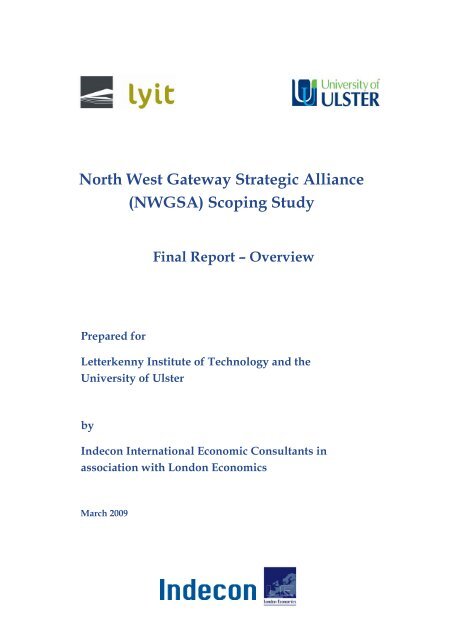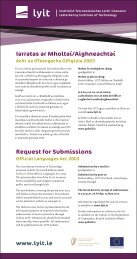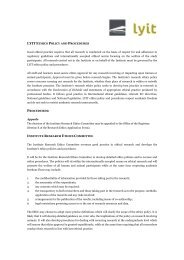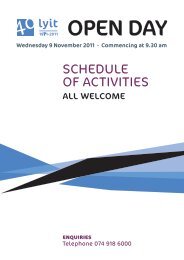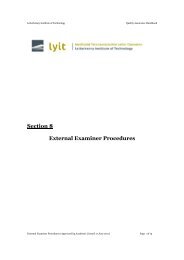Scoping Study Final Report.. - Letterkenny Institute of Technology
Scoping Study Final Report.. - Letterkenny Institute of Technology
Scoping Study Final Report.. - Letterkenny Institute of Technology
You also want an ePaper? Increase the reach of your titles
YUMPU automatically turns print PDFs into web optimized ePapers that Google loves.
North West Gateway Strategic Alliance(NWGSA) <strong>Scoping</strong> <strong>Study</strong><strong>Final</strong> <strong>Report</strong> – OverviewPrepared for<strong>Letterkenny</strong> <strong>Institute</strong> <strong>of</strong> <strong>Technology</strong> and theUniversity <strong>of</strong> UlsterbyIndecon International Economic Consultants inassociation with London EconomicsMarch 2009
North West Gateway Strategic Alliance (NWGSA) <strong>Scoping</strong> <strong>Study</strong>Overview1. IntroductionThis independent <strong>Scoping</strong> <strong>Study</strong> has been prepared by Indecon InternationalEconomic Consultants, in association with London Economics, for the University <strong>of</strong>Ulster (Ulster) and <strong>Letterkenny</strong> <strong>Institute</strong> <strong>of</strong> <strong>Technology</strong> (LYIT). The purpose is toexamine whether scope exists for the delivery <strong>of</strong> additional higher education (HE) inthe North West Gateway Strategic Alliance Region (NWGSA Region), which hasbeen defined to comprise County Donegal in the Republic <strong>of</strong> Ireland (RoI) and the sixNorthern Ireland (NI) local authority areas corresponding to Coleraine BoroughCouncil, Limavady Borough Council, Derry City Council, Strabane District Council,Omagh District Council and Fermanagh District Council.2. Overview, Vision and the Role <strong>of</strong> Higher EducationWhile the NWGSA Region has traditionally suffered from geographic and economicisolation in relation to the rest <strong>of</strong> the island <strong>of</strong> Ireland, some encouraging socioeconomicdevelopments have been occurring over recent years to which Ulster andLYIT have contributed significantly. These include population growth and thepresence <strong>of</strong> innovative firms.Other positive socio-economic characteristics include a large level <strong>of</strong> population –with 500,000 residents the NWGSA Region is one <strong>of</strong> the most populous regions in theisland <strong>of</strong> Ireland. It includes the linked ‘<strong>Letterkenny</strong>-Derry’ Gateway under the IrishNational Spatial Strategy (NSS) (2002-2020) and Derry has been identified as a majorregional city for the North West (including Donegal) in Shaping Our Future, theRegional Development Strategy for NI (which runs to 2025). The <strong>Letterkenny</strong>-DerryGateway is the largest linked gateway, and the only cross-border gateway, in theNSS.With a combined population <strong>of</strong> over 125,000 persons in 2006, the <strong>Letterkenny</strong>-DerryGateway is the fourth largest urban centre in the island <strong>of</strong> Ireland (after Dublin,Belfast and Cork) and it grew strongly by 3.3% between 2002 and 2006 (in contrast,the population <strong>of</strong> Greater Belfast contracted during this period). Further,<strong>Letterkenny</strong> has been the fastest growing urban centre in RoI with a higher educationinstitution (HEI) (2002-2006).Telecommunications infrastructure in the <strong>Letterkenny</strong>-Derry Gateway (includinghigh-speed broadband) is being enhanced and transport infrastructure across (andwithin) the NWGSA Region has witnessed significant improvements in recent years,facilitating improved access between the region and other parts <strong>of</strong> the island <strong>of</strong>Ireland (as well as within the region). The region also benefits from two airports, onein the west (at Carrickfinn in the Donegal Gaeltacht) and one in the east (at Eglington,County Londonderry) and both facilitate international as well as national access tothe region.Indecon and London Economics March 2009 Page 1
North West Gateway Strategic Alliance (NWGSA) <strong>Scoping</strong> <strong>Study</strong>In our ‘vision’ for the NWGSA Region, we anticipate higher levels <strong>of</strong> educationalattainment among residents and a greater emphasis on knowledge-based activities,including higher-order functions such as business development and innovation. Wealso envisage the region will become more attractive for high value added activitiessuch as internationally-traded services (including s<strong>of</strong>tware development andbusiness services) by virtue <strong>of</strong> continuing to be a cost competitive location.The NWGSA Region will also continue to benefit from a high quality <strong>of</strong> life and,together with its other comparative economic strengths, could become an even moreattractive location for people to live, work and study, including those born in theregion but who have spent their working lives to date elsewhere (for examplebecause they undertook their third-level studies outside the region and/or emigratedfrom the region to find employment).A key requirement in helping to realise this ambitious vision for the NWGSA Regionover the next decade (notwithstanding the currently very challenging economicclimate) is the need to boost the provision <strong>of</strong> HE in both parts <strong>of</strong> the region. Theanalysis presented in the <strong>Scoping</strong> <strong>Study</strong> reveals that LYIT and Ulster have played asignificant role in the positive developments underway in the NWGSA Region andthese include growth in course development (despite a more challenging marketenvironment in the form <strong>of</strong> an absence <strong>of</strong> growth in the number <strong>of</strong> residents aged 15-24 years in the NWGSA Region during 1996-2006) and support to local business andindustry in the form <strong>of</strong> mentoring and collaborative R&D.However, our analysis also indicates that there is need to further augment HEprovision in the NWGSA Region. This finding comes across very clearly in both ourquantitative analysis <strong>of</strong> existing data and in the new primary research evidencegained from our internal and external stakeholder consultations in the NWGSARegion.In particular, despite the gains <strong>of</strong> recent years, educational attainment in the regionremains low in comparison with elsewhere in the island <strong>of</strong> Ireland and the level <strong>of</strong>HE course provision (on a per capita basis) is also relatively low. For example, whilethe population <strong>of</strong> the NWGSA Region has grown more rapidly than that <strong>of</strong> GreaterBelfast during 2002-2006, the degree <strong>of</strong> HE course provision (per head <strong>of</strong> population)is much higher in Greater Belfast. In fact, among all the comparator regionsconsidered in the <strong>Scoping</strong> <strong>Study</strong>, including the Greater Dublin Area (GDA), RoI andNI as well as Greater Belfast, the NWGSA Region is found to have the lowestestimated density <strong>of</strong> HE provision (as well as having the lowest level <strong>of</strong> highereducational attainment).Central to achieving the vision outlined above is the need to build on the gains madeby LYIT and Ulster in recent years (which have helped to underpin the socioeconomicdevelopment <strong>of</strong> the NWGSA Region) and to further augment both the leveland quality <strong>of</strong> HE provision in the region so that it is at least on a par with elsewherein the island <strong>of</strong> Ireland. The importance <strong>of</strong> the need to boost HE in the region reflectsthe increasing weight placed on encouraging the development <strong>of</strong> knowledge-basedactivities in the policy/strategy arena and we believe this is especially pertinent inthe case <strong>of</strong> the NWGSA Region.Indecon and London Economics March 2009 Page 2
North West Gateway Strategic Alliance (NWGSA) <strong>Scoping</strong> <strong>Study</strong>A central conclusion <strong>of</strong> this <strong>Scoping</strong> <strong>Study</strong> is that the most effective means <strong>of</strong> furtherboosting HE provision in the NWGSA Region is through strategic collaborationbetween Ulster and LYIT (the two leading third-level education providers in theregion) aimed at enhancing the degree <strong>of</strong> collaboration in three categories – coursedevelopment, research and technology exchange with local business and industry.The new internal and external stakeholder consultation evidence presented in the<strong>Scoping</strong> <strong>Study</strong> reveals a very significant level <strong>of</strong> support (in each part <strong>of</strong> the NWGSARegion as well as within each institution) for enhanced strategic collaborationbetween Ulster and LYIT aimed at boosting the quantity and quality <strong>of</strong> HE provisionin the region.The very positive and consistent stakeholder views regarding enhanced collaborationbetween Ulster and LYIT are with respect to the following aspects <strong>of</strong> HE provision: Full-time undergraduate courses; Full-time postgraduate programmes; Part-time undergraduate and postgraduate study – lifelong learning; Recognition <strong>of</strong> prior learning/accreditation <strong>of</strong> prior (experiential) learning(RPL/AP(E)L) as a means <strong>of</strong> ensuring lifelong learning; Collaboration with local business and industry regarding R&D/innovationand the attainment <strong>of</strong> other higher-order functions (e.g. businessdevelopment); Specialist incubation support for new business starts in high-tech sectorswith significant growth and employment potential.We identify in the <strong>Scoping</strong> <strong>Study</strong> areas within each <strong>of</strong> the above where we believeenhanced collaboration between Ulster and LYIT may be feasible. Such enhancedcollaboration is aligned with each institution’s strategic plan and is consistent withtheir respective commitments to the NWGSA Region. It also reflects ourconsultations with stakeholders in the region as well as the existing strengths <strong>of</strong>Ulster and LYIT in the NWGSA Region.The benefits from enhanced collaboration for both institutions and the NWGSARegion overall should not be underestimated. Leveraging the skills and expertise <strong>of</strong>both institutions and catering for a larger demographic area will facilitate greaterimpact and utilisation <strong>of</strong> talent over a wider geographic area. Combined with theother cross-border initiatives currently underway in the region, which are consideredin the <strong>Scoping</strong> <strong>Study</strong>, local business and industry will become more aware <strong>of</strong> otherexisting businesses via networking, technology events/seminars and signpostingactivities (facilitated by Ulster and LYIT).Indecon and London Economics March 2009 Page 3
North West Gateway Strategic Alliance (NWGSA) <strong>Scoping</strong> <strong>Study</strong>3. Methodological Approach and Stakeholder ConsultationsOur methodological approach has involved quantitative and qualitative analyses <strong>of</strong>various data and information compiled by the Indecon/LE Consultancy Team(including analysis pertaining to current and future demographic trends in theNWGSA Region and other regions, including NI and RoI).In addition to our analyses <strong>of</strong> various existing data sources, our methodologicalapproach also includes the results <strong>of</strong> external and internal stakeholder consultationscarried out during the course <strong>of</strong> the <strong>Scoping</strong> <strong>Study</strong>.The external stakeholders with whom we consulted included, in each part <strong>of</strong> theNWGSA Region, the inward investment agencies, enterprises boards, tourismagencies, chambers <strong>of</strong> commerce and local authorities.We also consulted with senior representatives <strong>of</strong> the Higher Education Authority(HEA) in Dublin and the Department for Employment and Learning (DEL) in Belfast.Our external stakeholder consultations also included two new surveys in each part <strong>of</strong>the NWGSA Region, namely the Indecon/LE Survey <strong>of</strong> Businesses and Employers inDonegal and the Indecon/LE Survey <strong>of</strong> Businesses and Employers in the NI part <strong>of</strong>the NWGSA Region. We had originally targeted approximately 100 responses foreach <strong>of</strong> these surveys but the outcome in each case exceeded initial expectations – wereceived 151 responses from businesses and employers in Donegal and 144 responsesfrom business and employers in the NI part <strong>of</strong> the NWGSA Region, bringing the totalnumber <strong>of</strong> survey responses received from businesses and employers across theNWGSA Region to 295.The fourth component <strong>of</strong> our external consultation programme involved two furthersurveys in each part <strong>of</strong> the NWGSA Region, namely the Indecon/LE Survey <strong>of</strong> Post-Primary Schools in Donegal and the Indecon/LE Survey <strong>of</strong> Post-Primary Schools inthe NI part <strong>of</strong> the NWGSA Region (including sixth-form colleges). It was originallyagreed that we would consult with a sample <strong>of</strong> 2/3 post-primary schools/sixth formcolleges in each part <strong>of</strong> the NWGSA Region. However, in order to gain as full apicture as possible from this aspect <strong>of</strong> the external consultation programme, wedecided to significantly broaden it out and we wrote to post-primary schools andsixth-form colleges across the NWGSA Region. As a result, we received 26completed survey questionnaires from second-level schools and sixth-form collegesin the NWGSA Region (10 from the NI part and 16 from the Donegal part <strong>of</strong> theregion).Our consultations with internal stakeholders entailed the design and carrying out <strong>of</strong>staff and student surveys at each <strong>of</strong> Ulster and LYIT (i.e. four dedicated surveys): Indecon/LE Survey <strong>of</strong> Staff at Ulster; Indecon/LE Survey <strong>of</strong> Students at Ulster; Indecon/LE Survey <strong>of</strong> Staff at LYIT; Indecon/LE Survey <strong>of</strong> Students at LYIT.Indecon and London Economics March 2009 Page 4
North West Gateway Strategic Alliance (NWGSA) <strong>Scoping</strong> <strong>Study</strong>These surveys were undertaken electronically through adaptation <strong>of</strong> the surveyquestionnaires in respect <strong>of</strong> Ulster’s and LYIT’s respective internal staff and studentcommunication systems. The numbers <strong>of</strong> responses gained in each case were asfollows: Indecon/LE Survey <strong>of</strong> Staff at Ulster (all campuses) resulted in 441completed survey questionnaires; Indecon/LE Survey <strong>of</strong> Students at Ulster (all campuses) elicited 863completed survey questionnaires; Indecon/LE Survey <strong>of</strong> Staff at LYIT (undertaken at LYIT’s Killybegs campusas well as its <strong>Letterkenny</strong> campus) resulted in 151 completed surveyquestionnaires; Indecon/LE Survey <strong>of</strong> Students at LYIT (Killybegs campus as well as the<strong>Letterkenny</strong> campus) elicited 110 completed survey questionnaires.The other key elements <strong>of</strong> our internal consultation programme were (in addition toour regular liaising with members <strong>of</strong> the Project Team comprising members fromUlster and LYIT): Indecon/LE presentation to, and discussion with, the EB (Executive Board) <strong>of</strong>LYIT on 27 August 2008; Indecon/LE presentation to, and discussion with, the SMG (SeniorManagement Group) at Ulster on 6 October 2008; Consultations with each <strong>of</strong> the three LYIT/Ulster <strong>Scoping</strong> <strong>Study</strong> WorkingGroups on 6 November 2008 (face-to-face and via video-link);oooWorking Group on HE operating environment and collaborativemodelsWorking Group on external consultation andknowledge/technology exchangeWorking Group on course/programme development andresearch Presentation <strong>of</strong> our preliminary emerging findings to the <strong>Scoping</strong> <strong>Study</strong>Steering Committee on 7 November 2008 – those in attendance included Dr.Don Thornhill (Chairman <strong>of</strong> the National Competitiveness Council in RoI)and Pr<strong>of</strong>essor Sir David Melville (Chair <strong>of</strong> Lifelong Learning UK).Indecon and London Economics March 2009 Page 5
North West Gateway Strategic Alliance (NWGSA) <strong>Scoping</strong> <strong>Study</strong>4. Strategic and Policy ContextThe strategic and policy context <strong>of</strong> the <strong>Scoping</strong> <strong>Study</strong> comprises a number <strong>of</strong> levels,the highest <strong>of</strong> which is to ensure enhanced educational attainment and skillsacquisition as key inputs into the Lisbon Goal, which aims to make the EU “the mostcompetitive and dynamic knowledge-based economy in the world capable <strong>of</strong>sustainable economic growth with more and better jobs and greater social cohesion”.High-level policy studies in the context <strong>of</strong> all-island initiatives, such as theComprehensive <strong>Study</strong> on the All-Island Economy (2006) and the All-Island Skills<strong>Study</strong> (2008), emphasise cross-border collaboration in higher education.Various studies and initiatives underway in the NWGSA Region recognise theimportance <strong>of</strong> improving educational attainment in the region and the importance <strong>of</strong>enhancing co-operation between Ulster and LYIT as the two principal HEIs in theNWGSA Region.Our review <strong>of</strong> the strategic context <strong>of</strong> the <strong>Scoping</strong> <strong>Study</strong> suggests the importance <strong>of</strong>strategic collaboration between LYIT and Ulster across the range <strong>of</strong> HE activities (atall levels), including full-time undergraduate courses, postgraduate courses, lifelonglearning and knowledge/technology exchange with business and industry.A theme cutting across all these aspects <strong>of</strong> potential collaboration between Ulster andLYIT is the importance <strong>of</strong> developing skills and qualifications in science, technology,engineering and maths (STEM). Enhancing skills in STEM are increasingly beingrecognised as critical to the development <strong>of</strong> knowledge-based activities in business,finance and healthcare as well as in science, engineering and technology.Owing to its peripheral location in the island <strong>of</strong> Ireland, we believe that the need toenhance STEM is critically important in the NWGSA Region and an effective meansby which this may be achieved in practice is through enhanced strategic collaborationbetween LYIT and Ulster as the leading third-level education providers in the region.5. Socio-Economic Pr<strong>of</strong>ile <strong>of</strong> the NWGSA RegionOur socio-economic pr<strong>of</strong>ile <strong>of</strong> the NWGSA Region has revealed the following results.1. The NWGSA Region has a large population base amounting to almost 500,000persons (based on 2006 figures). This represents a 4% increase on the level in2002 and the level and recent growth in population are important in determiningthe availability <strong>of</strong> a critical mass <strong>of</strong> population in the NWGSA Region to supportdemand for HE.2. While population density across the region is below that for NI and RoI, there area number <strong>of</strong> areas <strong>of</strong> high population density, including Derry/Londonderry and<strong>Letterkenny</strong>.3. Within the NWGSA Region, recent population growth has been strongest inDonegal (7% between 2002 and 2006), bringing the county’s population to 147,264persons in 2006. The NI part <strong>of</strong> the region saw its population expand by 3% overthis period, to reach 349,700 persons by 2006.Indecon and London Economics March 2009 Page 6
North West Gateway Strategic Alliance (NWGSA) <strong>Scoping</strong> <strong>Study</strong>4. The population <strong>of</strong> the linked <strong>Letterkenny</strong>-Derry Gateway amounted to 125,490persons in 2006. Outside the major urban areas <strong>of</strong> Dublin, Belfast and Cork, the<strong>Letterkenny</strong>-Derry Gateway has the largest population base among the 14gateway cities/towns in RoI and is one <strong>of</strong> the largest inter-urban areas in theisland <strong>of</strong> Ireland.5. With a population <strong>of</strong> 17,586 persons in 2006, <strong>Letterkenny</strong> enjoyed the fastestgrowth in population out <strong>of</strong> the 11 cities and towns in RoI with a HEI since 2002(15% growth cumulatively or 3.7% per annum on average during 2002-2006).6. The proportion <strong>of</strong> the population in the 0-14 year age cohort is relatively high inthe NWGSA Region compared with RoI and NI, suggesting a comparatively high‘latent’ demand for HE in the region for the next few years.7. However, during the past decade (1996-2006), there was no growth in thenumber <strong>of</strong> residents in the NWGSA Region aged 15-24 years and the number <strong>of</strong>people in this age category fell by 0.6% per annum in Donegal.8. Projections for population developed by Indecon/London Economics (based on<strong>of</strong>ficial population forecasts in NI and RoI) suggest the following outcomes interms <strong>of</strong> the likely pattern <strong>of</strong> prospective demand for HE in the NWGSA Regionover the medium- to long-term (until 2021):i. A likely driver <strong>of</strong> the growth in HE demand in the NWGSA Region willbe from the 25+ age cohort. This relates to ‘non-traditional’ students andlifelong learners, including people seeking to enhance or differentiatetheir skills;ii. Across the NWGSA Region, the absolute and relative population in the‘traditional’ new entrant (15-24 years) cohort is expected to decline andthis may lead to a decline in HE demand among this group (although notnecessarily so in the event that a greater proportion <strong>of</strong> the persons agedbetween 15 and 24 years enrol on HE courses, which may be likely) –thus, it is not necessarily correct to say that there will be a decline in thetraditional segment <strong>of</strong> the HE intake in the NWGSA Region over thecoming years.9. Despite the gains in student enrolments achieved by LYIT and Ulster in theNWGSA Region in recent years, the level <strong>of</strong> higher educational attainment(among residents) is relatively low in the NWGSA Region: in the NI part <strong>of</strong> theRegion, 17% <strong>of</strong> the working age population had a primary degree or higher in2006 compared with 23% in NI as a whole; in the Donegal part <strong>of</strong> the NWGSARegion, 12.5% <strong>of</strong> persons aged 15+ years had a primary degree or higherqualification in 2006 compared with 18.5% for RoI. These facts are likely toreflect the structure <strong>of</strong> economic activity and employment in the region.Indecon and London Economics March 2009 Page 7
North West Gateway Strategic Alliance (NWGSA) <strong>Scoping</strong> <strong>Study</strong>10. The NWGSA Region has a lower proportion <strong>of</strong> its employment base in marketservices activities (36% versus 41% across the RoI and 40% across NI). In nonmarketservices – which largely equates to the public sector – 39% <strong>of</strong> totalemployment in the region is located in this sector. This compares with 40%across NI but is substantially above that across the RoI (28%). Within theNWGSA Region, it is notable that the primary sectors (including agriculture andutilities) are relatively important employers in Donegal, while the constructionsector is also relatively important in that county. Reflecting nationaldevelopments, the region will need to grow high value internationally-tradedmarket services activities.11. <strong>Final</strong>ly in respect <strong>of</strong> our socio-economic pr<strong>of</strong>ile, notwithstanding the positivedevelopments in relation to FDI, key shares <strong>of</strong> foreign-owned activity in the NIpart <strong>of</strong> the NWGSA Region remain disproportionately low in relation to relativesize <strong>of</strong> the population <strong>of</strong> this part <strong>of</strong> the region. In Donegal, the figures indicate aconcentration <strong>of</strong> foreign-owned company employment in pharmaceuticals andhealthcare, with companies in this sector accounting for half <strong>of</strong> all IDA Irelandassistedfirms in the county. The ICT sector is also an important employer inDonegal. These areas <strong>of</strong> concentration point to the importance <strong>of</strong> developingskills in STEM subjects.6. Higher Education Operating Environment – Comparative HE Systemsin RoI and NIWe have carried out a detailed review <strong>of</strong> the respective HE operating environmentsin NI and RoI aimed at assessing whether there might be any systems differences thatwould act to impede the possibility <strong>of</strong> enhanced strategic collaboration betweenUlster and LYIT in the context <strong>of</strong> the NWGSA Region. Our review <strong>of</strong> HE systems ineach jurisdiction has also considered the similarities, which would tend to makepotential co-operation easier.Our overall assessment is that some institutional factors currently in place might limitthe scope to develop full-time, undergraduate courses separately or jointly by LYITand/or Ulster in the NWGSA Region – namely the MaSN Cap in NI and differencesin tuition fees between NI and RoI.However, if these constraints are overcome, we believe there could be significantpotential to develop full-time undergraduate provision jointly in the NWGSARegion. While the MaSN cap is likely to remain a feature <strong>of</strong> the NI HE system, it maybe possible to review its application in the case <strong>of</strong> STEM subjects and there is also thepossibility <strong>of</strong> the cap being differentiated on a regional basis.We consider that there is also likely to be significant scope to develop courses inlifelong learning and at postgraduate level where differences between the two HEoperating systems appear to be less significant and the MaSN Cap does not apply.Lifelong learning in this context is interpreted broadly – including part-time study forpeople hoping to acquire third-level qualifications and part-time postgraduate studyfor people with existing third-level qualifications.Indecon and London Economics March 2009 Page 8
North West Gateway Strategic Alliance (NWGSA) <strong>Scoping</strong> <strong>Study</strong>Apart from tuition fee differences and the MaSN Cap, we do not believe that otherdifferences in the HE operating environments North and South are likely to impedeenhanced collaboration between LYIT and Ulster for the betterment <strong>of</strong> the NWGSARegion. Existing joint initiatives between LYIT and Ulster – notably the MSc inInnovation Management in the Public Services – clearly demonstrate how differencesin operating systems can be overcome (graduates from this novel programme gaindual accreditation, namely an MSc with the Ulster brand and RoI HETAC Level 9branding, which is both unique and attractive to students).7. Higher Education Operating Environment – Pr<strong>of</strong>iles <strong>of</strong> Ulster and LYITBoth LYIT and Ulster have experienced impressive expansion in recent years and thishas been an important input into the positive socio-economic developmentsoccurring in the NWGSA Region, including population growth, employment growthand the presence <strong>of</strong> a number <strong>of</strong> innovative enterprises in the Donegal and NI parts<strong>of</strong> the region. It is also important to recognise that the growth in student numbersachieved by Ulster and LYIT has come against a more difficult market environment –as stated earlier the number <strong>of</strong> residents aged between 15 and 24 years has declinedin certain parts <strong>of</strong> the region.Ulster is the largest provider <strong>of</strong> HE in NI – in fact in the island <strong>of</strong> Ireland – withapproximately 24,000 students in 2007/08. It is a significant contributor to theNWGSA Region: in 2007/08, Ulster’s Magee and Coleraine campuses togetheraccounted for over 9,000 full-time and part-time undergraduate and postgraduatestudents and both campuses currently employ in the region <strong>of</strong> 2,000 staff (headcountbasis) (almost 1,400 on full-time equivalent basis).Taking Ulster’s Magee and Coleraine campuses together, our analysis reveals thatpart-time undergraduate and postgraduate numbers have grown more rapidly thanfull-time undergraduate and postgraduate numbers in the NWGSA Region duringthe past decade. This trend reflects Ulster’s commitment to lifelong learning in theNWGSA Region and is further illustrated by the fact that part-time students as aproportion <strong>of</strong> all students has risen at Ulster’s Magee and Coleraine campuses during1997/98-2007/08.Magee and Coleraine together had over 7,600 undergraduate enrolments in 2007/08,making up almost 40% <strong>of</strong> Ulster’s total undergraduate population in that year. Keyfaculties at Magee and Coleraine are Life and Health Sciences (1,749 and 990undergraduate enrolments at Coleraine and Magee respectively in 2007/08), theUlster Business School (1,119 and 618 undergraduate enrolments at Coleraine andMagee respectively in 2007/08) and Arts (1,063 and 609 undergraduate enrolments atColeraine and Magee respectively in 2007/08). Also important at Magee are theFaculty <strong>of</strong> Social Sciences and the Faculty <strong>of</strong> Computing and Engineering – the latteraccounted for 619 undergraduate enrolments and the former for 579 such enrolmentsin 2007/08.Indecon and London Economics March 2009 Page 9
North West Gateway Strategic Alliance (NWGSA) <strong>Scoping</strong> <strong>Study</strong>Turning to postgraduate students at Ulster, most (84% in 2007/08) are enrolled ontaught programmes (which involve research via dissertation or minor thesis). Wellover2,000 students were enrolled on taught and research postgraduate programmesat both Coleraine and Magee in 2007/08. By faculty, the largest postgraduateenrolments in Coleraine occur in Life and Health Sciences, Social Sciences and Arts;the largest postgraduate enrolments at Magee occur in Social Sciences, the UlsterBusiness School, Arts and Life and Health Sciences.In terms <strong>of</strong> mode <strong>of</strong> study, most (72% in 2007/08) postgraduate study at Ulster isundertaken on a part-time basis. By type <strong>of</strong> postgraduate study, the majority <strong>of</strong> parttimepostgraduate students at Ulster are enrolled on taught programmes while most<strong>of</strong> the research programmes at Ulster (that is, research masters and doctoral study)are accounted for by full-time postgraduate students. Within the NWGSA Region,part-time postgraduate study is larger than full-time postgraduate study in Coleraineand Magee – part-time study is especially important among taught programmes inColeraine, particularly in Life and Health Sciences (in 2007/08, 1,063 part-timestudents were enrolled in taught postgraduate programmes, <strong>of</strong> which 886 or 83%were enrolled in the Life and Health Sciences Faculty).The relatively large numbers <strong>of</strong> student enrolments in part-time (taught)postgraduate study at Ulster further reflects Ulster’s commitment to lifelong learningand skills development across NI and beyond (as some <strong>of</strong> the students are resident inRoI).Ulster has a strong record <strong>of</strong> achievement in research. In the most recent UKResearch Assessment Exercise (RAE) (December 2008), there were especially strongperformances in Nursing and Celtic Studies (with 100% <strong>of</strong> research in these areasclassified as international quality). Across the university as a whole, 86% <strong>of</strong> researchactivity was rated as being <strong>of</strong> international quality and almost 20% classed as worldleading.The results also confirm Ulster’s research excellence in Biomedical Sciences,Law, Architecture and the Built Environment, Media Studies and Art and Design.Significant improvement in the quality <strong>of</strong> research in areas such as Computing andNanotechnology were also recorded.Ulster’s campuses in the NWGSA Region play an important role in its researchstrengths. Coleraine is home to the Centre for Molecular Biosciences, which is at theheart <strong>of</strong> international research into molecular and nutritional aspects <strong>of</strong> degenerativediseases and microbial and pharmaceutical biotechnology and comprisesapproximately 200 research staff and doctoral students. The Centre for FunctionalGenomics, established in Coleraine in October 2003 at Ulster’s Coleraine campus with£2m (€2.2m) funding from the EU Programme for Peace and Reconciliation, aims toaugment the existing world-class biotechnology and biomedical facilities at Coleraineby creating a specialist Centre <strong>of</strong> Excellence in Functional Genomics (CFG),concentrating on research projects that may have commercial impact onbiotechnology, biomedicine or high-added-value food production. The Centre forCoastal and Marine Research is also located on the Coleraine campus, providing aworld-class facility for research into coastal environments and coastal geology,archaeology and management.Indecon and London Economics March 2009 Page 10
North West Gateway Strategic Alliance (NWGSA) <strong>Scoping</strong> <strong>Study</strong>As well as Celtic Studies, other research strengths at Magee include: IT andElectronics; Creative Multi-media; Design; International Business; Psychology;Nursing; and areas <strong>of</strong> Arts and Social Sciences (History and Social Policy). Centres <strong>of</strong>Excellence include the Intelligent Systems Research Centre (ISRC), the Academy forIrish Cultural Heritages, the <strong>Institute</strong> <strong>of</strong> Ulster Scots Studies, the Transitional Justice<strong>Institute</strong> and INCORE (International Conflict Research). Also notable is the fact thatthere are a number <strong>of</strong> initiatives currently underway at Magee with the potential toboost research activities at this campus as well as further developing its provision <strong>of</strong>niche undergraduate and postgraduate courses. The new initiatives include theCreative Technologies (Industries) Research Centre; the Centre for PostgraduatePr<strong>of</strong>essional Legal Education; the Clinical Translational Research and InnovationCentre (CTRIC) at Altnagelvin; Financial Services; Construction, Quantity Surveyingand Spatial Planning; and Psychology.Knowledge/technology exchange and the commercial exploitation <strong>of</strong> ideas arepromoted by the Office <strong>of</strong> Innovation at Ulster through a range <strong>of</strong> initiatives andongoing collaboration with business and industry (which is appropriately widelydefined to include new starts and SMEs as well as international businesses withfacilities in NI and the NWGSA Region). Ulster’s participation in such activitiesincludes collaboration with local business and industry through the FUSIONProgramme (an all-island initiative managed by InterTradeIreland) and KnowledgeTransfer Partnerships.Ulster’s science research parks at Coleraine, Magee and Jordanstown are aimed atsupporting the clustering <strong>of</strong> knowledge-based companies. The Magee Science Parkfocuses on s<strong>of</strong>tware development and advanced IT, the Coleraine Science Park onlife, health and environmental technologies and the Jordanstown Science Parkconcentrates on engineering, medical devices and s<strong>of</strong>tware. The science parks atMagee and Coleraine have been successful in incubating a range <strong>of</strong> entrepreneurialventures and in generating significant new high quality employment locally.Within the Magee Science Park, the <strong>Technology</strong> and S<strong>of</strong>tware Innovation Centre(TSIC) provides 3,000 sq ft <strong>of</strong> <strong>of</strong>fice space. A S<strong>of</strong>tware Development Centre provides4,000 sq ft <strong>of</strong> space for companies graduating from TSIC or ICT-based R&Dcompanies seeking to establish a close and dedicated interaction with Ulster. Thefacilities at Magee have seen 10 firms ‘graduating’ in the past five years and 9 arecurrently under incubation (employment growth to date among the 10 graduatorfirms is estimated to be approximately 50% and the 9 firms currently underincubation account for about 70 employees). Ulster’s Science Research Park at itsColeraine campus, concentrating on life, health and environmental technologies,reflecting Coleraine’s international research excellence in the life and health sciences,contains the Science Innovation Centre (SIC), which provides a strong location forbioscience R&D companies and also for companies developing s<strong>of</strong>tware for thehealthcare sector and bio-informatics applications. The Science Innovation Centreprovides 8,500 sq ft <strong>of</strong> <strong>of</strong>fice space and laboratory space. In the past five years atUlster’s Coleraine Science Research Park, 12 firms have graduated and 8 are currentlyactive employing in the region <strong>of</strong> 30 staff; employment among the current 11 firmsunder incubation is approximately 50 and most <strong>of</strong> these firms involve localentrepreneurs.Indecon and London Economics March 2009 Page 11
North West Gateway Strategic Alliance (NWGSA) <strong>Scoping</strong> <strong>Study</strong>LYIT is the leading third-level education provider in Donegal. Established in 1971, ithas approximately 3,000 students, comprising in the region <strong>of</strong> 2,500 full-time studentsand 400 part-time students over two campuses, the main campus in <strong>Letterkenny</strong> (thelargest urban centre in Donegal) and the tourism and hospitality campus inKillybegs, the largest fishing port in RoI.The built environment at LYIT has undergone significant transformation over recentyears. Investment in infrastructure <strong>of</strong> more than €50m (£45m) was made during1997-2005, creating an additional 17,000 square metres <strong>of</strong> accommodation. TheBusiness Development Centre (BDC), launched in 2000, was funded by €3m (£2.7m)from INTERREG and today provides 1,100 square metres <strong>of</strong> specialist incubationspace and associated supports for new start-up businesses in high-tech sectors. Phase2 <strong>of</strong> the BDC development is due to be completed at the end <strong>of</strong> 2008 and will add anadditional 400 square metres at a cost <strong>of</strong> €2.7m (£2.4m) – funding is via EnterpriseIreland under the NDP. Further research facilities encompassing 700 square metres ata cost <strong>of</strong> €1.2m (£1.1m) will be constructed in conjunction with Phase 2 <strong>of</strong> the BDC,funded by the Department <strong>of</strong> Education and Science under the NDP. It is envisagedthat the total 2,200 square metres <strong>of</strong> space dedicated to specialist research andbusiness incubation facilities at LYIT will be complete in February 2009.In 2007/08, 18 firms were tenants <strong>of</strong> the BDC and the number <strong>of</strong> firms fully spun-outfrom the centre totalled 19 during 2003/04-2007/08. The planned completion <strong>of</strong> theBDC should see more tenants being accommodated and even more high-tech spinoutactivity in the coming years.Most courses on <strong>of</strong>fer at LYIT are at bachelor degree or higher – <strong>of</strong> the 66 courses in2007/08, over 75% were at these levels, including 20 bachelor degrees at honourslevel and 6 postgraduate degrees at masters level. The latter included that MSc inInnovation Management in the Public Service, a unique, specialist course <strong>of</strong>feredjointly by LYIT and Ulster on a part-time basis throughout the island <strong>of</strong> Ireland andan example <strong>of</strong> successful existing co-operation between the two institutions.The growth in undergraduate numbers in the Schools <strong>of</strong> Engineering and Science atLYIT is also noteworthy, not least in the context <strong>of</strong> encouraging greater study <strong>of</strong>STEM subjects at third-level (and in view <strong>of</strong> the aforementioned challenging marketin Donegal, in which the number <strong>of</strong> residents aged 15-24 years declined during 1996-2006).Like Ulster, LYIT has a strong tradition <strong>of</strong> catering for mature students (those aged 23years plus) – in 2006/07, mature students accounted for 22% <strong>of</strong> all undergraduates,illustrating LYIT’s commitment to lifelong learning in the NWGSA Region.At postgraduate level, LYIT <strong>of</strong>fers a range <strong>of</strong> taught Masters degrees in the Schools <strong>of</strong>Business and Science. The largest <strong>of</strong> these, in terms <strong>of</strong> student numbers, is the MSc inInnovation Management in the Public Service, which is <strong>of</strong>fered jointly (as statedabove, on a part-time basis) with Ulster and is jointly accredited in both the RoI andthe UK (demonstrating that the differences in accreditation between RoI and NI areunlikely to impede new course development on a joint basis between Ulster andLYIT).Indecon and London Economics March 2009 Page 12
North West Gateway Strategic Alliance (NWGSA) <strong>Scoping</strong> <strong>Study</strong>Notwithstanding its relative small size, LYIT benefits from a number <strong>of</strong> researchactivities, including marine biotechnology (CAMBio) and electronics, production andinnovation (EpiCentre), which brings together Ulster, LYIT and NWRC (North WestRegional College). In December 2008, it was announced that the EpiCentre project atLYIT is to benefit from Enterprise Ireland funding <strong>of</strong> over €1m (£1.1m) to aid theconstruction <strong>of</strong> the WiSAR Lab within the project (Wireless Sensor AppliedResearch). This is a significant development for LYIT and the NWGSA, not leastbecause <strong>of</strong> LYIT’s collaboration with Ulster in the EpiCentre project and the fact thatthere is also collaboration between EpiCentre and CAMBio (and the Machine VisionResearch Group at LYIT, which is active in games programming, inter alia).8. Existing Collaboration between Ulster and LYITThe extent <strong>of</strong> collaboration between LYIT and Ulster has expanded in recent yearsand plays an important role in supporting the development <strong>of</strong> the linked<strong>Letterkenny</strong>-Derry Gateway and the NWGSA Region.Initiatives in joint course development between Ulster and LYIT include: The MSc in Innovation Management in the Public Service – jointly accreditedby HETAC and Ulster (the only such course in the island <strong>of</strong> Ireland to be soaccredited), this postgraduate programme had a total stock <strong>of</strong> 61 studentsenrolled in 2007/08 (all cohorts) and produced 25 graduates in 2006/07 (11from NI and 14 from RoI); and The Postgraduate Certificate in Higher Education Practice (PgCHEP) – thiscourse is delivered by Ulster to LYIT lecturing staff at LYIT as a means <strong>of</strong>ensuring high quality standards at LYIT and <strong>of</strong>fers graduates the possibility <strong>of</strong>proceeding to obtain diploma and masters qualifications in higher education.Further, Ulster’s Diploma in Nursing at LYIT provided the foundation for thesubsequent development <strong>of</strong> LYIT’s own suite <strong>of</strong> nursing degrees, namely the BSc(Hons) in General Nursing (annual intake <strong>of</strong> 30 students), the BSc (Hons) inIntellectual Disability Nursing (annual intake <strong>of</strong> 20 students) and the BSc (Hons) inPsychiatric Nursing (annual intake <strong>of</strong> 25 students). These HETAC Level 8 coursescommenced at LYIT in 2002 and are funded by the Department <strong>of</strong> Health andChildren. The growth <strong>of</strong> nursing studies has been one <strong>of</strong> the main successes <strong>of</strong> LYITin recent years and, coupled with the fact that Ulster pioneered (within the UK HEsystem) third-level nursing degree courses at Coleraine and Magee, it would appearthat the NWGSA Region may have a competitive advantage in the provision <strong>of</strong>pr<strong>of</strong>essional nursing education, not least in view <strong>of</strong> the fact that <strong>Letterkenny</strong> andAltnagelvin also boast major hospitals in close proximity to each other.Joint initiatives between Ulster and LYIT in research and technology exchangeinclude the aforementioned EpiCentre and the North West Science and <strong>Technology</strong>Partnership. Both initiatives also involve NWRC and are aimed at developingknowledge-based activities in the NWGSA Region.Indecon and London Economics March 2009 Page 13
North West Gateway Strategic Alliance (NWGSA) <strong>Scoping</strong> <strong>Study</strong>9. Assessment <strong>of</strong> Existing Higher Education Provision in the NWGSARegionAn important aspect <strong>of</strong> the <strong>Scoping</strong> <strong>Study</strong> is our assessment <strong>of</strong> the existing level <strong>of</strong>HE provision in the NWGSA Region, taking account also <strong>of</strong> that in other key regions,including RoI and NI.Our analysis suggests that, despite the noteworthy gains made by Ulster and LYITover recent years, including their collaborative initiatives, there is a comparably lowlevel <strong>of</strong> HE provision in the NWGSA Region and that preference for the region as aplace to study is not a particularly strong factor currently influencing a student’schoice regarding where to undertake his or her HE study.There are a number <strong>of</strong> key elements underpinning this assessment.The first such element is our analysis in respect <strong>of</strong> estimating the ‘density’ <strong>of</strong> HEprovision in the region and other parts <strong>of</strong> the island <strong>of</strong> Ireland – namely the number<strong>of</strong> full-time HE undergraduate and postgraduate students per head <strong>of</strong> the population(in particular, the overall population and the working age population (aged 15-64years) in each <strong>of</strong> the regions that we have considered).Our analysis <strong>of</strong> HE density reveals a relatively low level <strong>of</strong> HE provision in theNWGSA Region. In particular, the number <strong>of</strong> full-time HE students per 1,000 <strong>of</strong>population is estimated to be 20 in the NWGSA Region (comprising an estimated 16in the Donegal part and an estimated 22 in the NI part) compared with 23 in NI and32 in RoI. According to the analysis, the highest estimated densities in the island <strong>of</strong>Ireland are in the Greater Dublin Area (GDA) and Greater Belfast, with an estimateddensity <strong>of</strong> 54 in each case. When deflated by the working age population (15-64years) rather than the overall population, the estimates densities increase but thesame relative pattern is apparent, with the estimated density <strong>of</strong> HE provision lowestin the NWGSA Region (lowest <strong>of</strong> all in Donegal) and highest in the GDA and GreaterBelfast.The other elements <strong>of</strong> our assessment <strong>of</strong> the existing level <strong>of</strong> HE provision in theNWGSA Region (in a comparative context) make use <strong>of</strong> the new Indecon/LE primaryresearch evidence.According to the Indecon/LE Survey <strong>of</strong> Business and Employers in the NWGSARegion (2008), the main perceived strengths <strong>of</strong> existing HE provision in the region areas follows: Overall capacity <strong>of</strong> HE facilities (59.7% <strong>of</strong> respondents indicated that this factoris a ‘very important’ or ‘important’ strength); Range <strong>of</strong> taught undergraduate courses (53.2%) (although almost 1-in-4 als<strong>of</strong>elt that this is a ‘very important’ or ‘important’ weakness); Quality <strong>of</strong> graduates (52.9%).However, none <strong>of</strong> the above factors were perceived to be particularly significantstrengths, judging by the magnitude <strong>of</strong> the proportions indicating ‘very important’ or‘important’ strength in our business/employer survey.Indecon and London Economics March 2009 Page 14
North West Gateway Strategic Alliance (NWGSA) <strong>Scoping</strong> <strong>Study</strong>The main perceived weaknesses <strong>of</strong> existing HE provision in the NWGSA Region(according to respondents <strong>of</strong> our business and employer survey) include: The extent and depth <strong>of</strong> collaboration between higher education institutionsand business (35.3% regarded this as a ‘very important/important’ weakness); The quality <strong>of</strong> incubation/support facilities for business start-ups (30% <strong>of</strong>participants regarded this as a ‘very important/important’ weakness); Range and quality <strong>of</strong> adult/life-long learning programmes (29.3% <strong>of</strong>respondents regarded this as ‘very important/important weakness).However, like the main perceived strengths, none <strong>of</strong> the main perceived weaknesses<strong>of</strong> HE provision in the region are viewed by local businesses and employers asparticularly significant (judging by the magnitude <strong>of</strong> the proportions indicating ‘veryimportant’ or ‘important’ weakness).Turning to our surveys <strong>of</strong> students at Ulster and LYIT, our new primary researchevidence indicates that the two most important factors in students’ decision to studyat Ulster (all campuses) are quality <strong>of</strong> their chosen course/programme (96% <strong>of</strong>respondents felt that this factor is ‘very important’ or ‘important’) and availability <strong>of</strong>a place on their preferred course (89%). Preference for the North West as a location tostudy emerged as the least important factor underpinning students’ decision to studyat Ulster (36% <strong>of</strong> respondents said that this factor is ‘very important’ or ‘important’).Students at LYIT are in clear agreement with their counterparts at Ulster that quality<strong>of</strong> chosen course/programme and availability <strong>of</strong> a place on students’ preferredcourse are the most important factors in students’ decisions to study at LYIT (theproportions indicating ‘very important’ or ‘important’ factors were 92% and 91%respectively). Preference for the North West as a location to study was seen as theleast important <strong>of</strong> factors cited in students’ decision to study at LYIT (56.3% <strong>of</strong>respondents said that this is ‘very important’ or ‘important’).With regard to our survey <strong>of</strong> post-primary schools and sixth-form colleges in theregion, our new primary research evidence indicates that availability <strong>of</strong> preferredcourse is a key factor influencing a school-leaver’s decision to study at a particularHE institution (96% <strong>of</strong> respondents felt that it is ‘very important’ or ‘important’). Onthe other hand, a relatively low proportion <strong>of</strong> respondents (40%) indicated thatpreference for the region as a place <strong>of</strong> study is ‘very important’ or ‘important’.10. Views Regarding Enhancing Higher Education Provision in theNWGSA RegionWe have considered both external and internal views regarding the potential benefits,and possible disadvantages, <strong>of</strong> enhanced collaboration between Ulster and LYIT.The results from our survey <strong>of</strong> businesses and employers in the NWGSA Region arenoteworthy for the strength <strong>of</strong> views placed on the need to enhance the range andquality <strong>of</strong> HE in the region and also for the very high degree <strong>of</strong> consistency in viewsamong businesses and employers in the Donegal and NI parts <strong>of</strong> the region. Acrossthe region, businesses and employers attach a very high degree <strong>of</strong> importance toimproving the range and quality <strong>of</strong> undergraduate, postgraduate and lifelonglearning study as well as initiatives aimed at enhancing commercialisation <strong>of</strong> researchand R&D.Indecon and London Economics March 2009 Page 15
North West Gateway Strategic Alliance (NWGSA) <strong>Scoping</strong> <strong>Study</strong>Second-level schools/sixth-form colleges in the region emphasise the importance <strong>of</strong><strong>of</strong>fering a wider range <strong>of</strong> undergraduate courses with pr<strong>of</strong>essional accreditation andenhanced relationships/links with local businesses and employers in the NWGSARegion. Schools in the region also believe that opportunities to engage in study ineach part <strong>of</strong> the region (e.g. Donegal as well as the NI part and vice-versa) areimportant in influencing students’ decisions to remain and study in the region.The survey results in respect <strong>of</strong> students at Ulster and LYIT echo the second-levelschools survey results in that existing students at either institution are <strong>of</strong> the viewthat a greater range <strong>of</strong> undergraduate courses/programmes and more suchprogrammes with pr<strong>of</strong>essional accreditation would make studying in the NWGSARegion more attractive. Enhanced relationships/links with local business andindustry are also felt to be important in helping to make third-level study in theregion more attractive.Our surveys <strong>of</strong> staff at Ulster and LYIT exhibit a high level <strong>of</strong> agreement on theimportance <strong>of</strong> a range <strong>of</strong> potential benefits from enhanced collaboration betweenUlster and LYIT. The very positive survey results reveal likely significant benefits asincluding the development <strong>of</strong> new undergraduate and postgraduate courses, raisingthe pr<strong>of</strong>ile <strong>of</strong> LYIT and Ulster in NI and RoI respectively and opportunities forcollaborative research and technology exchange. Also noteworthy is the consistentview that enhanced collaboration between Ulster and LYIT is unlikely to constrainpossible linkages between each <strong>of</strong> these institutions and other HEIs.11. Summary <strong>of</strong> Findings and Potential Collaboration OpportunitiesThe main findings <strong>of</strong> the <strong>Scoping</strong> <strong>Study</strong> are given in the following table.Main Findings <strong>of</strong> the <strong>Scoping</strong> <strong>Study</strong>There is considerable scope, and need, to develop and enhance the provision and role <strong>of</strong>higher education (HE) for the betterment <strong>of</strong> the NWGSA Region in the following areas:Full-time undergraduate course development;Full-time postgraduate programme development;Part-time undergraduate and postgraduate study – lifelong learning;Collaboration with local business and industry regarding information andtechnology exchange, R&D/innovation and the attainment <strong>of</strong> other higher-orderfunctions (e.g. business development);Specialist incubation and graduator support for businesses in high-tech sectors withsignificant growth and employment potential.Source: Indecon/LE.Indecon and London Economics March 2009 Page 16
North West Gateway Strategic Alliance (NWGSA) <strong>Scoping</strong> <strong>Study</strong>A tabular summary <strong>of</strong> the factors underpinning the main findings <strong>of</strong> the <strong>Scoping</strong><strong>Study</strong> are set out in the table below.Factors Underpinning the Main Findings <strong>of</strong> the <strong>Scoping</strong> <strong>Study</strong>1. At the highest level is the importance <strong>of</strong> enhancing educational attainment and skillsacquisition as key inputs into the development <strong>of</strong> the knowledge-based economy (LisbonGoal).2. High-level policy studies in the context <strong>of</strong> all-island initiatives, such as the Comprehensive<strong>Study</strong> on the All-Island Economy (2006) and the All-Island Skills <strong>Study</strong> (2008), emphasisecross-border collaboration in higher education.3. Various cross-border initiatives currently underway in the NWGSA Region recognise theimportance <strong>of</strong> improving educational attainment in the Region and the importance <strong>of</strong>enhancing co-operation between Ulster and LYIT as the leading third-level educationproviders in the region.4. The analysis <strong>of</strong> independent and <strong>of</strong>ficial data reveals a relatively low level <strong>of</strong> HE provisioncurrently in the NWGSA Region, which may act as a competitive weakness <strong>of</strong> the Region –on a per-capita basis, the number <strong>of</strong> full-time HE students in each part <strong>of</strong> the NWGSARegion is lower compared with other parts <strong>of</strong> the island <strong>of</strong> Ireland as well as NI and RoIoverall.5. The socio-economic pr<strong>of</strong>ile <strong>of</strong> the NWGSA Region indicates a need for the region to ‘catchup’with elsewhere in the island <strong>of</strong> Ireland in terms <strong>of</strong> HE provision and in terms <strong>of</strong> highereducational attainment among its residents.6. New survey evidence reveals very strong support among local businesses and employersfor enhanced co-operation between Ulster and LYIT for the economic development <strong>of</strong> theNWGSA Region.7. New survey evidence further reveals very strong support among both staff and students ateach <strong>of</strong> Ulster and LYIT for enhanced co-operation in HE.8. The areas identified above for enhanced collaboration are consistent with projected demanddevelopments in HE within the NWGSA Region as well as reflecting the very positivesupport <strong>of</strong> external and internal stakeholders in the region9. The proposed areas for enhanced collaboration also take account <strong>of</strong> differences in the HEoperating environments North and South, including the cap on full-time undergraduatestudents in NI and fee differences – we believe these should not adversely affect plans forenhanced co-operation between LYIT and Ulster.10. The proposed areas for enhanced collaboration also reflect the respective strategic plans <strong>of</strong>LYIT and Ulster.11. Enhanced collaboration will also have long-run strategic value for each institution – forexample, enhanced collaboration will permit Ulster to develop its presence in the South andwill facilitate LYIT to broaden its learner base.12. Enhanced collaboration is also likely to open up new opportunities for Ulster and LYIT toaccess EU research funds.13. Enhanced collaboration is also likely to be significant in a wider EU and internationalcontext – it would serve to project a positive signal for the NWGSA Region that could leadto further benefits for the Region and for each institution.Source: Indecon/LE.Indecon and London Economics March 2009 Page 17
North West Gateway Strategic Alliance (NWGSA) <strong>Scoping</strong> <strong>Study</strong>The next table overleaf presents a tabular summary <strong>of</strong> potential opportunities arisingfrom enhanced collaboration between LYIT and Ulster, under the main headings <strong>of</strong>cross-cutting themes, full-time undergraduate course development, full-timepostgraduate course development, lifelong learning, research and technologyexchange (which comprises a broad range <strong>of</strong> activities including training foremployers and employees, mentoring support, IP and R&D).Other possible areas that may work to the mutual advantage <strong>of</strong> both institutionsconcerns attracting international students to the NWGSA Region – given the naturalbeauty and unique features <strong>of</strong> the area and the opportunity to engage in study in avaried range <strong>of</strong> subjects.Indecon and London Economics March 2009 Page 18
North West Gateway Strategic Alliance (NWGSA) <strong>Scoping</strong> <strong>Study</strong>Potential Collaborative Opportunities and Key RequirementsKey Cross-Cutting Themes <strong>of</strong> Enhanced CollaborationMaintain and develop existing collaboration between LYIT and UlsterEnsure a focus on developing STEM subjects vital for economic development (in business, finance and health aswell as in science and technology)Maximise complementary strengths <strong>of</strong> Ulster and LYITTailor collaboration towards local school-leavers and employers – to ensure greater retention <strong>of</strong> the brighteststudents in the region, development <strong>of</strong> high value employment and inward investment potentialFull-Time Undergraduate Course DevelopmentExpand the range <strong>of</strong> courses to attract and retain more students in the region (e.g. arts as well as technologysubjects, niche courses like renewable energy technologies, teacher training courses, ‘para’-pr<strong>of</strong>essional courses)Ensure rigorous quality standards on new jointly developed coursesConsider incorporating work placements as part <strong>of</strong> new collaborative coursesExpanding full-time undergraduate course provision will serve to create a ‘critical mass’ <strong>of</strong> HE in the region, whichin turn has the potential to generate further demand for postgraduate and executive education studyFull-Time Postgraduate Course DevelopmentMaintain and develop the MSc in Innovation Management in the Public Service (including variants aimed at otherexecutives)Maintain the Postgraduate Certificate in Higher Education Practice (PgCHEP) and subsequent qualificationopportunities (at diploma and masters levels)Consider the development <strong>of</strong> a ‘joint graduate school’ with centres at <strong>Letterkenny</strong>, Magee and ColeraineDevelop PhD capacity in Donegal (through doctoral study among LYIT staff and students at Ulster and other HEIs)– this would have the additional benefit <strong>of</strong> furthering developing research in LYITConsider also the development <strong>of</strong> ‘pr<strong>of</strong>essional PhDs’ in the region – e.g. DNSc (aimed at specialised nursingpractitioners in the region) (the DNSc is currently available at all Ulster campuses)Lifelong learningGiven the importance <strong>of</strong> skills acquisition and projected demographic trends, lifelong learning will becomecritically important in the socio-economic development <strong>of</strong> the NWGSA RegionIt will be particularly important to ensure lifelong learning in STEM subjects, in order to help underpin skillsdevelopment in relation to high value employment in the regionFundamental to maximising the potential <strong>of</strong> lifelong learning will be appropriate RPL/AP(E)L and flexible deliverymodes (including e-learning) – important that a consistent approach to both is taken by LYIT and Ulster in jointcourse developmentResearchSpecific areas <strong>of</strong> potential collaboration include marine, biomedicine, biotechnology, electronics, computing(including games), business and creative technologiesMaintain and develop existing collaborative initiatives (e.g. EpiCentre)Consider the development <strong>of</strong> Creative Technologies (Industries) Research Centre between Ulster (Magee), LYITand NWRC (North West Regional College)Potential to compete for future public research funds in RoI<strong>Technology</strong>/Knowledge ExchangeThis has significant potential given recent and planned developments at LYIT and UlsterEnhanced collaboration via pooling <strong>of</strong> expertise would see greater availability <strong>of</strong> experts, wider geographiccoverage (across the NWGSA Region), greater opportunities for student placements and support for such higherorderfunctions as business development and innovationEnsuring appropriate publicity and sign-posting <strong>of</strong> business support functions at LYIT and Ulster will be importantSource: Indecon/LE.Indecon and London Economics March 2009 Page 19
North West Gateway Strategic Alliance (NWGSA) <strong>Scoping</strong> <strong>Study</strong>12. Concluding RemarksThe overall conclusion <strong>of</strong> the <strong>Scoping</strong> <strong>Study</strong> is that there is need to further augmentthe provision <strong>of</strong> higher education (HE) in the NWGSA Region. The two largest HEproviders in the region – LYIT and Ulster – have a tradition <strong>of</strong> collaboration inteaching and research that has contributed to the development <strong>of</strong> the region, and weconsider that enhanced strategic collaboration between them <strong>of</strong>fers the most effectivemeans <strong>of</strong> boosting both the quantity and quality <strong>of</strong> HE provision in the region.The NWGSA Region has one <strong>of</strong> the largest populations in the island <strong>of</strong> Ireland andwe believe there is now a unique opportunity for both LYIT and Ulster to cometogether in a more proactive way than hitherto to grow their market, retain a largerproportion <strong>of</strong> the brightest and most talented students in the region and from otherparts <strong>of</strong> the island, enhance local worker skill levels and contribute significantly tothe economic, social and cultural development <strong>of</strong> the region.The next stage <strong>of</strong> the overall project will be to consider the development <strong>of</strong> the‘blueprint’ <strong>of</strong> how best to realise the enhanced collaboration identified in the <strong>Scoping</strong><strong>Study</strong>. We believe that the second stage <strong>of</strong> the project should examine (inter alia) thespecific complementary strengths <strong>of</strong> each institution (as identified in our institutionalpr<strong>of</strong>iles <strong>of</strong> LYIT and Ulster) and should also be mindful <strong>of</strong> various possible models <strong>of</strong>strategic collaboration among higher education institutions, including examples <strong>of</strong>existing collaboration internationally (which we have considered as part <strong>of</strong> ourresearch in the course <strong>of</strong> the <strong>Scoping</strong> <strong>Study</strong>). Consideration also needs to be given toany possible legislative implications or requirements <strong>of</strong> enhanced strategiccollaboration between Ulster and LYIT.Indecon and London Economics March 2009 Page 20
North West Gateway Strategic Alliance (NWGSA) <strong>Scoping</strong> <strong>Study</strong>AcknowledgementsIndecon and London Economics would like to acknowledge the very helpful supportprovided by LYIT and Ulster during the <strong>Scoping</strong> <strong>Study</strong>. Particular thanks are due toDanny Brennan (Registrar, LYIT), Pr<strong>of</strong>essor Bernie Hannigan (Pro-Vice Chancellor,Strategic Projects, Ulster), Dr. Aileen Moore (Vice-Chancellor’s Office, Ulster) andTracey Dobbs (Registrar’s Office, LYIT). We would also like to acknowledge thehelpful guidance and support provided by Pr<strong>of</strong>essor Richard Barnett (Vice-Chancellor, Ulster) and Paul Hannigan (Director, LYIT), and to the external advisersto Ulster and LYIT on this <strong>Scoping</strong> <strong>Study</strong> – Pr<strong>of</strong>essor Sir David Melville (for Ulster)and Dr. Don Thornhill (for LYIT). We would also like to acknowledge the inputs <strong>of</strong>the Senior Management Group (SMG) at Ulster and the Executive Board (EB) at LYIT.In particular, in addition to Paul Hannigan and Danny Brennan at LYIT, the LYIT EBmembers Billy Bennett (Head <strong>of</strong> School <strong>of</strong> Business), John Andy Bonar (Head <strong>of</strong>Development), Sean Duffy (Head <strong>of</strong> School <strong>of</strong> Tourism), Denis McFadden (Head <strong>of</strong>School <strong>of</strong> Engineering), Colin Morrow (Secretary and Financial Controller) and Dr.Gertie Taggart (Head <strong>of</strong> School <strong>of</strong> Science); and in addition to Pr<strong>of</strong>essors RichardBarnett and Bernie Hannigan <strong>of</strong> Ulster, the Ulster SMG members Pr<strong>of</strong>essor AlastairAdair (Pro-Vice Chancellor, Communication and External Affairs and Provost <strong>of</strong>Jordanstown and Belfast), Pr<strong>of</strong>essor Jim Allen (Pro-Vice Chancellor, Information andStudent Services and Provost <strong>of</strong> Magee), Pr<strong>of</strong>essor Norman Black (Pro-ViceChancellor, Research and Innovation), Pr<strong>of</strong>essor Denise McAlister (Pro-ViceChancellor, Teaching and Learning), Irene Aston (Director <strong>of</strong> Corporate Planning andGovernance), Peter Hope (Director <strong>of</strong> Finance), Ronnie Magee (Director <strong>of</strong> HumanResources), Paddy Donnelly (Director <strong>of</strong> Physical Resources), Pr<strong>of</strong>essor Alan Sharp(Provost, Coleraine), Noreen Taggart (Director <strong>of</strong> Communication and Development),Andrew Trimble (Director <strong>of</strong> Information Services), Pr<strong>of</strong>essor Pól Ó’Dochartaigh(Dean <strong>of</strong> Arts), Pr<strong>of</strong>essor Ian Montgomery (Dean <strong>of</strong> Art, Design and the BuiltEnvironment), Pr<strong>of</strong>essor Richard Millar (Dean <strong>of</strong> Computing and Engineering),Pr<strong>of</strong>essor Hugh McKenna (Dean <strong>of</strong> Life and Health Sciences), Pr<strong>of</strong>essor Anne Moran(Dean <strong>of</strong> Social Sciences) and Pr<strong>of</strong>essor Robert Hutchinson (Dean <strong>of</strong> the UlsterBusiness School). Special thanks are also due to the Working Groups <strong>of</strong> staffmembers from Ulster and LYIT specially convened for the purpose <strong>of</strong> this importantassignment; to Paddy Hannigan <strong>of</strong> the School <strong>of</strong> Engineering at LYIT who sat in all <strong>of</strong>the Working Groups; and to all other staff and students from Ulster and LYIT withwhom we consulted and who took the time to complete the survey questionnaires.We would also like to recognise the inputs <strong>of</strong> the private sector manufacturing andservices firms who inputted into the <strong>Scoping</strong> <strong>Study</strong> and all other externalorganisations (from the public and private sectors) and members <strong>of</strong> the public whotook the time to contribute to this very interesting and worthwhile study. <strong>Final</strong>ly, wewould like to acknowledge Michael McLoone (County Manager, Donegal), LiamFlanigan (Town Clerk and Chief Executive, Limavady Borough Council), RogerWilson (Chief Executive, Coleraine Borough Council), Valerie Watts (Chief Executive,Derry City Council), D McSorley (Chief Executive, Omagh District Council), PhilipFaithfull (Clerk and Chief Executive, Strabane District Council) and Rodney Connor(Chief Executive, Fermanagh District Council). A special thank you is also due toShane Crothers <strong>of</strong> the University <strong>of</strong> Ulster for taking the time to check and validatethe detailed data provided by the University. The usual disclaimer applies.Indecon and London Economics March 2009 Page 21


